This is an Aires 35-V, a 35mm rangefinder camera produced by Aires Camera Ind. Co., LTD in 1958. The Aires 35-V was part of Aires’s line of 35mm rangefinder cameras and is the only one with an interchangeable lens mount. Only four lenses were made using it’s proprietary lens mount, two 4.5cm standards, a 3.5cm wide angle, and a 10cm telephoto. It’s other features were an uncoupled selenium exposure meter, a viewfinder with multiple frame lines, double exposure prevention, and an automatic exposure counter. The Aires 35-V was the top of the line of all Aires rangefinders with a unique combination of features and a selection of Coral lenses that were capable of excellent images. Not many were made however, making them rare and highly collectible today.
Film Type: 135 (35mm)
Lens: 4.5cm f/1.8 H Coral coated 6-elements + 3.5cm f/3.2 W Coral coated 4-elements
Lens Mount: Aires 35-V Bayonet
Focus: 2.67 feet to Infinity
Viewfinder: Coincident Image Coupled Rangefinder w/ Multiple Projected Frame Lines
Shutter: Seikosha-MX Leaf
Speeds: B, 1 – 1/400 seconds
Exposure Meter: Uncoupled Selenium Cell w/ top plate readout
Battery: None
Flash Mount: Coldshoe and M and X Flash Sync
Weight: 892 grams (w/ 3.5cm lens), 866 grams (w/ 4.5cm lens), 733 grams (body only)
Manual: https://mikeeckman.com/media/Aires35VManual.pdf
How these ratings work |
The Aires 35-V was the pinnacle of Aires’s camera line-up and was their only model with an interchangeable lens mount. With a selenium exposure meter, a large and bright viewfinder with multiple frame lines, and a medium format Seikosha shutter, the 35-V had every feature a late 1950s photographer could want, but it’s success was hampered by a high price, and a feature set that was perhaps a few years too late. Still, when found in working condition, this camera is as good as any Aires made, and with one of their excellent Coral lenses, was capable of excellent images. | ||||||
| Images | Handling | Features | Viewfinder | Feel & Beauty | History | Age | |
| 2 | 1 | 2 | 2 | 2 | 1 | 30% | |
| Bonus | none | ||||||
| Final Score | 13.0 | ||||||
Aires was a maker of fine cameras who in my opinion was one of the best Japanese camera makers of the 1950s, despite being in business for barely over a decade. From their first camera in 1949, the twin lens Yallu Flex, to their last camera in 1960, the Radar-Eye, the company’s short 11 year run was filled with a large number of pretty fantastic cameras.
It is clear that whoever worked for Aires, knew how to make great cameras and lenses, as Aires’s 35mm rangefinder series and their Coral lenses were quite good. I’ve reviewed both the Aires 35-III L and the Radar-Eye on this site and gave both high marks for their excellent build quality, attractive looks, and excellent lenses.

Where the company went wrong is that I think they invested too heavily in 35mm rangefinders, not realizing the importance of developing a SLR as by the time the company did finally release one, it was a half-hearted fixed lens leaf shutter model that couldn’t compete in the market place. Another possible explanation for their quick downfall was their over dependence on their US distributor, Kalimar, who when they were first formed in 1952 polluted the market with cameras made by dozens of Japanese and Soviet cameras rebadged under their own name. Perhaps they weren’t keen to allow Aires cameras to be sold without being rebadged as a Kalimar model, but that’s my own speculation however.

Whatever the reason for their quick exit, during a short period of time in the mid to late 1950s, if you wanted a quality Japanese 35mm rangefinder for an affordable price, Aires had a good variety to choose from. From the unmetered Aires Viscount with an f/2.8 lens to the metered Aires 35 IIIC with fast f/1.9 lens they had something for everyone.
Their best model, and only one to feature interchangeable lenses was the Aires 35-V from 1958. This camera packed in nearly every feature available in the 35mm rangefinder market, including the company’s fastest 7-element f/1.5 S-Coral lens, both a wide angle and telephoto 3.5cm and 10cm lens, an uncoupled selenium exposure meter, bright and easy to use coupled rangefinder, and a fully flash synchronized Seikosha-MX shutter.
The 35-V uses a larger Seikosha-MX #0 shutter which was normally used in medium format cameras like the Konishiroku Koniflex and Olympus-Flex TLR. The reason for using the larger shutter is because of the larger throat required for the faster S-Coral f/1.5 lens. Had Aires used a smaller Seikosha #00 shutter, the smaller throat would have caused vignetting using the faster lens. Being a medium format shutter, the #0 had heavy duty springs which would have improved it’s durability, but a side effect was the top speed was lowered from 1/500 on the #00 to 1/400 on the #0. This might have seemed like a minor “con” to the camera, but my guess is that most people would be willing to forgive a slightly slower maximum speed to have the benefit of the faster f/1.5 lens.
When it went on sale, the camera sold with the f/1.5 lens for $159.50. The 3.5cm and 10cm wide angle and telephoto lenses were an extra $59.50 and $89.50 respectively. For the owner who wanted to go all in, there was a complete kit with all three lenses and a fitted camera case for $325.25. These prices, when adjusted for inflation compare to $1435, $535, $805, and $2930 respectively today. Strangely, I could not find any prices, or even a mention of the slower 4.5cm f/1.8 lens equipped on the model I have.
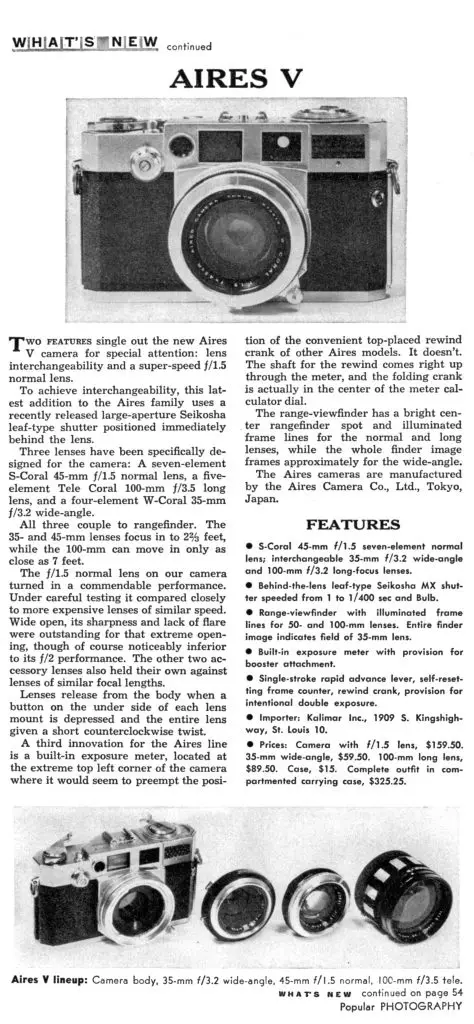
There was a lot to like about all Aires cameras, but the 35-V was the king. At a price of $159.50, it is said that Aires lost money on every camera they sold, hoping that success of the model would have led to sales of the other lenses, helping to offset the development cost of the camera.
Sadly, this didn’t happen as Kalimar did a poor job of marketing the camera in the United States. Advertisements for the model were sparse, and apart from the short one-page article to the right from the December 1958 issue of Popular Photography, the camera received very little attention.
Abysmal sales of the 35-V were the final nail in the coffin for Aires who was already struggling to compete with the growing Japanese camera market and the emergence of the 35mm SLR.
Today, Aires cameras have a small but loyal following among collectors. The 35-V, being the highest spec camera, is one of the most collectable, and when found with the f/1.5 Coral lens can fetch prices of several hundreds of dollars. Whether you get one with that, or a lesser lens though, it is a fantastic camera that is deserving of being included in any collection.
My Thoughts
Ever since I reviewed my first Aires camera back in 2015, I’ve been a fan of the brand. In that time I’ve acquired a few other models, like the Radar-Eye, the 35-III C and the Penta, but the 35-V has eluded me. For a budget minded collector like myself, this camera has the double whammy of being both uncommon and desirable. Lens-less bodies regularly sell from Japanese sellers at prices over $100 and with a lens quite a bit higher, so when I saw this camera in a lot with not only the 4.5cm lens but also the 3.5cm lens at a price I could live with, I knew I had to jump on it.
As is the case with every other Aires rangefinder I’ve held, the build quality is excellent. This is a heavy camera in which no weight saving materials appear to be used. With the standard 4.5cm f/1.8 lens mounted, the camera weighs in at just under 2 pounds (866 grams) making this a stout piece of metal.
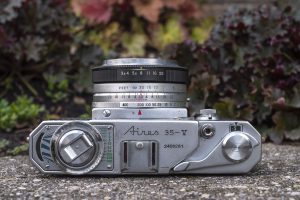
The top plate is heavily dominated by the uncoupled selenium exposure meter, but otherwise has all the controls in the usual locations you’d expect them. The rewind lever has a nice fold down handle that lays almost perfectly flat on the top of the exposure meter, lower than other rangefinders. In the center is an accessory shoe below the Aires 35-V logo. On the right is the film advance lever, cable threaded shutter release button, and automatic resetting exposure counter.
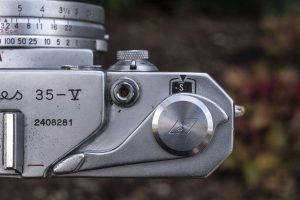
As is the case on every other Aires rangefinder I’ve handled, the motion of the film advance lever is very stiff and a tad gritty. Having handled at east four other Aires rangefinders, I can confirm they’re all stiff, suggesting that’s just how these cameras were made, but this one is the only one where I can feel some grit, suggesting some dirt or otherwise gunk has gotten in there somewhere.
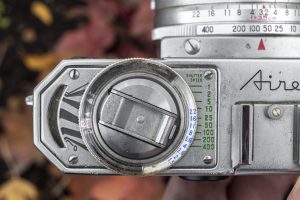
The exposure meter is uncoupled, which means that changing either the shutter speed or f/stop on the lens has no effect on the meter. Any reading you take, requires you to manually set both on the camera.
Although a pretty ordinary design, it’s implementation is a tad confusing. The first step to using it is to calibrate it for your film speed by setting the outer ASA film scale, with numbers from 5 to 500 in red to whatever speed film is in the camera. In the image to the left, it is set to ASA 100.
With the camera at waist level, point it at what you want to take a picture of, and pay attention to the white needle on the far left and look at which stripe it is pointing to. Once the needle stops moving, you need to rotate the entire dial so the arrow above your film speed points to the corresponding stripe that leads to the needle. If you want to overexpose your shot, use the other arrow.
Once you have the arrow pointing to the correct stripe, look at the f/stop (in blue) and shutter speed (in green) marks on the right and choose any combination that is paired up. So for example, in the above example, 1/25 @ f/16, 1/100 @ f/8, and 1/400 @ f/4 would all expose the image correctly.
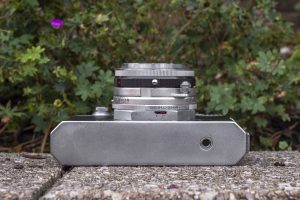
On the bottom of the camera, we see the 1/4″ tripod socket off to the right side, and beneath the shutter is a sliding switch for M and X flash synchronization. At the very base of the lens is a chrome button which acts as a lens release for swapping lenses. In the image to the right, I have the 4.5cm f/1.8 lens, but on the 3.5cm f/3.2, this button has a red dot in the center, and is off to the side.
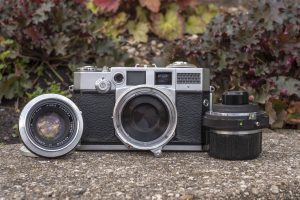
The lens mount is a pretty robust bayonet mount that wouldn’t look out of place on a focal plane SLR. All Aires 35-V lenses have a lens release button on the lens itself, rather than the camera, but the process for changing lenses varies slightly between the 4.5cm and 3.5cm lenses (I am not sure about the 10cm as I don’t have one).
With the more common 4.5cm lens, there is a red dot on the black ring, to the left of the chrome lens release button. To remove the lens, press and hold the lens release button and twist the lens counterclockwise until the red dot on the lens matches up with a red dot on the body, which is near the 7 o’clock position around the mount. Installation is the opposite. Line up the red dots and twist clockwise until it clicks in place.
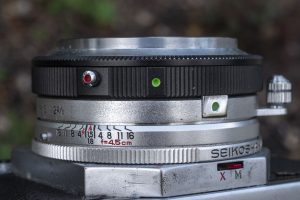
With the wide angle 3.5cm lens, the lens release button doubles as the red dot index mark that needs to be lined up with the red dot on the body, but there are also two green dots that are both on the lens itself. In order to both remove and attach the lens, you must line up both green dots on the lens to a indentation on the body that one of the tabs slides into. Once the tab and green dots are lined up, a clockwise twist of the lens will lock it into position. Removing the lens is the same as the 4.5cm lens. Why Aires had two different methods for mounting each lens is a mystery to me, although to be fair, it’s far simpler to do than my explanation probably suggest.
With the lens off, you can really appreciate the larger size of the Seikosha #0 medium format shutter. It’s actually a shame this wasn’t a focal plane camera as it would have allowed for some really creative lenses (assuming the 35-V ended up being successful).
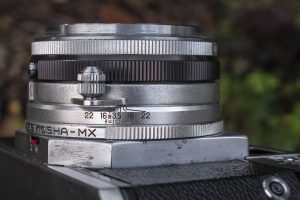
One last clever detail about the lens mount for the Aires 35-V is that on the camera itself, in between the chrome focusing ring, and the shutter speed ring, is the depth of field scale that can be rotated to one of three positions, one each for the 3.5cm, 4.5cm, and 10cm lenses. When you change lenses, you can rotate this ring to show an appropriate depth of field scale for the lens you have mounted. In the image earlier in this article where I show the top plate of the camera, you can see the scale for the 3.5cm lens, and in the previous lens showing the green dots, you can see the scale for the 4.5cm lens. The image to the right shows the scale for the 10cm lens.
Attaching a new lens requires lining up a red dot on the lens with the red dot near the 7 o’clock position around the mount and giving it a short clockwise twist.
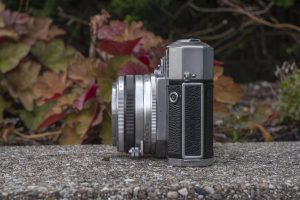
The left side of the camera has a sliding latch for releasing the film door. On an angled face right in front of the latch is the flash sync port.
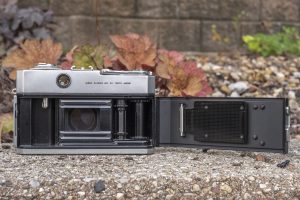
Film travels from left to right onto a fixed and double slotted take up spool. The film gate has dual polished film rails, the pressure plate is oversized and has divots on it, and the film door itself has a metal roller, all of which are there to aide in smooth and flat film transport. Although the film compartment is about as wide as a 35mm SLR of the era, the distance from the supply cassette and the take up spool to the film gate is slightly narrower which means you should more easily get an extra exposure or two on each roll of film.
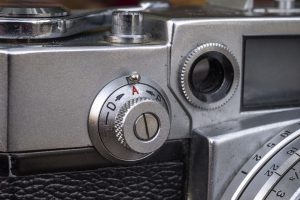
When it is time to rewind your film, the metal dial on the front of the camera must be turned from A (Advance) to R (Rewind). A small locking tab at the top must be pressed to turn the knob away from the A position. A third position, indicated by the letter D is there for intentional double exposures in which winding the advance lever only cocks the shutter but does not transport the film. The location and design of this knob look curiously similar to the slow speed dial found on the Leica III and other similar cameras, and I wonder if this was done intentionally to suggest a Leica-like feature.

The viewfinder is large and bright with an overall blue tint and two sets of pink tinted projected frame lines and circular rangefinder patch. The frame lines are only indicated for the 4.5cm and 10cm telephoto lenses. When using the 3.5cm lens, the entire viewfinder window, outside of the 4.5cm lines is to be used. In the image to the right, I struggled to capture the 10cm frame lines, so they do not show up well in my image, but they are there and are much easier to see in person.
The Aires 35-V’s manual repeatedly refers to the viewfinder as being a “trimming” rangefinder which was their way of promoting that you can see outside of the frame lines while composing your image. Earlier rangefinders did not have frame lines and what you saw through the viewfinder was intended to be all that was captured on film, but with a trimming rangefinder, by seeing more of what won’t be captured, you can more easily frame your image to get exactly what you want.
I asked around a couple of collectors to see if they remember other companies using the term “trimming” rangefinder, or if it was just an Aires thing, and the consensus is that a few other companies might have promoted their coupled rangefinders differently, “trimming” was unique to Aires.
The Aires 35-V was the top of the line of all Aires rangefinders with a modern list of features, a selection of excellent lenses, and a good viewfinder, but what is it like to use?
My Results
I wanted to shoot the Aires with both the 4.5cm standard and 3.5cm wide angle lenses, but with the winter months fast approaching and my opportunities for good lighting dwindling, it took longer than I had expected. The first roll I completed was a 30+ year expired roll of Kodak Plus-X black and white film that I conservatively rated at 100. I shot this roll entirely with the 3.5cm lens.
Despite being barely faster than Kodak TMax 100, I am always surprised by the amount of grain in Plus-X 125. I’m not saying it’s a bad thing, but clearly there’s something to Kodak’s “T-Grain” technology, but that’s a discussion for another article.

The first results from the Aires 35-V with the wide angle lens were stunning. I’ve always been a fan of wide angle shots, especially on rangefinders as without the handicap of a through the lens viewfinder, there’s a little more wiggle room for cropping if you don’t get your exposure perfectly centered.
According to the manual, the 3.5cm f/3.2 W Coral is a 4-element lens, which puts it on par with the W-Nikkor 3.5cm f/3.5 and Leitz Elmar 3.5cm f3.5 rangefinder lenses, so it’s in good company. Sharpness is excellent in the center with some softness creeping into the corners. I didn’t notice strong vignetting, although looking through my shots, I didn’t get many “sky shots” where it would have been especially noticeable. Not having shot color film with this lens, I can’t speak of any chromatic errors, but my guess is they’re probably pretty well controlled.
For the second roll, I wanted to shoot some color and decided upon a roll of expired Kodak ProImage 100 that I split with another camera. I used the standard 4.5cm f/1.8 lens for this whole roll.
Unfortunately, my choice of expired color film combined with some operational problems that started to creep in resulted in a less than inspiring roll. For starters the film suffered some really strange color shifts that I haven’t seen with other rolls of this film. Kodak ProImage is a rather new film and with a speed of 100, should have aged much better than this as every outdoor shot had a strong cyan and magenta cast to it. I tried to minimize this color shift in Photoshop, so the images in the gallery above are after I tried to improve them. They were worse right out of the scanner.
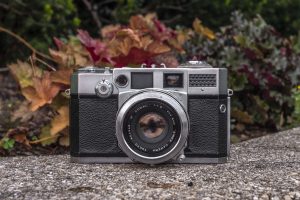
Also, unlike the first roll with the wide angle 3.5cm lens, I started having problems with both the film advance and shutter. I’ve used several Aires rangefinders before, and they all have had a tight film advance lever, but the one on this 35-V definitely had some grit in there that probably worked it’s way into places where it didn’t belong. I didn’t notice it on the first roll, but by the second, the film advance became very difficult which is why I gave up halfway through the 36 exposure roll and moved the second half to another camera.
Worse though, I had noticed the shutter started to stick. A sticky shutter on a half century leaf shutter camera is hardly a surprise, and I’m actually disappointed in myself for not flushing it before using the camera, but it seemed to be good to go for the first roll, so I didn’t bother.
A third issue that is very obvious in the mirror selfie shot is that I consistently missed focus on this lens, likely due to rangefinder misadjustment. It is likely that the problem existed during the first roll, but due to the wide angle lens having a greater depth of field, was less noticeable.
With a camera that is suffering from a tight and gritty film advance, a sticky shutter, and a rangefinder that’s out of adjustment, it’s probably a little unfair that I finished this review, but I feel that through my two rolls, I had enough time with the camera that I can reasonably extrapolate what shooting with a perfect working one might be like, plus, with experience shooting other Aires rangefinders and knowing what to expect from their Coral lenses, I feel justified in my conclusions.
In previous reviews for the Aires 35-III L and Radar Eye, I declared Aires cameras to be a terrific option to other Japanese fixed lens rangefinders from the 1950s. Every Aires camera I’ve held and shot has been built well, made great images, and in my research for those models, seemed to be incredible values at the time they were being sold.
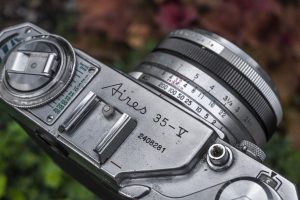
The Aires 35-V is in some ways the pinnacle of Aires rangefinder development, but it wasn’t successful. I’ve read a bit that they struggled with distribution, but I can’t help but guess that Aires always seemed to be playing catch up with the rest of the market. They never innovated with any of their products, instead releasing capable alternatives to others. The decision to release the company’s first interchangeable lens camera in 1958 is strange as I feel they were about five years too late. Certainly interchangeable lens rangefinders still sold, but they were almost exclusively high end models by Leica, Canon, or Nikon. The market for a mid-level option with a lens mount incompatible with any other camera system was likely a tough sell.
It’s a shame really, as these were nice cameras with good lenses and despite the challenges I faced with this one, I think that when found in good working condition, they are fun and capable cameras. I really enjoy wide angle lenses on rangefinders, and the performance of the 3.5cm f/3.2 W Coral lens might be this camera’s saving grace, motivating me to send it out for a CLA. If I ever do that, I will certainly update this review, but for now, I can declare the Aires 35-V a fine camera that’s worth adding to your collection, but just don’t expect to have a shooting experience much different from anything else out there.
Related Posts You Might Enjoy
External Links
http://tazmpictures.com/site/?p=3884
http://www.ajcc.gr.jp/sub1.45.html#Aires35V
http://corsopolaris.net/supercameras/aires/aires.html
https://www.thephotoforum.com/threads/aires-35-v.338681/
https://www.photo.net/discuss/threads/info-on-aires-35-v-rangefinder.14928/
http://www.collection-appareils.fr/x/html/page_standard.php?id_appareil=10353

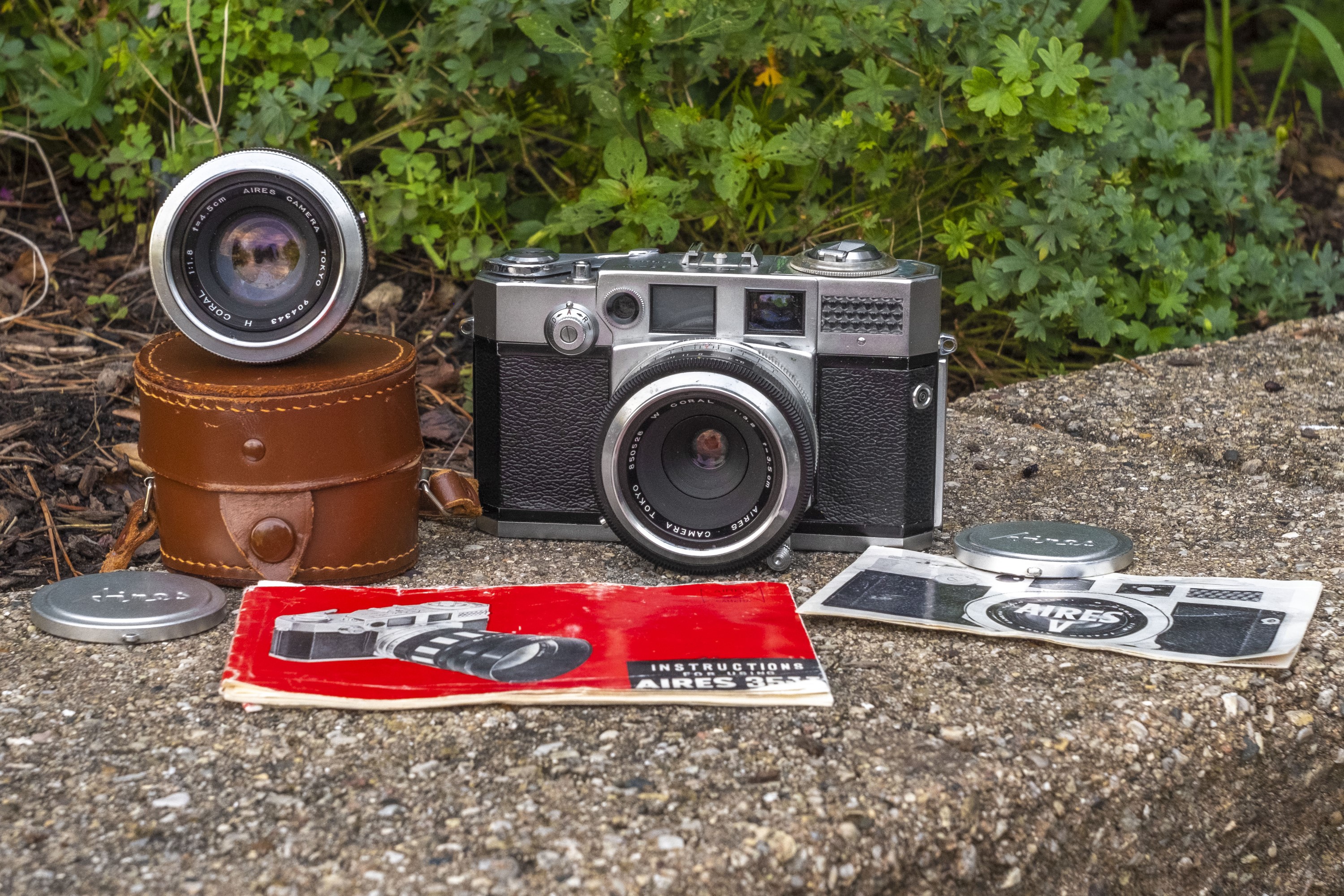

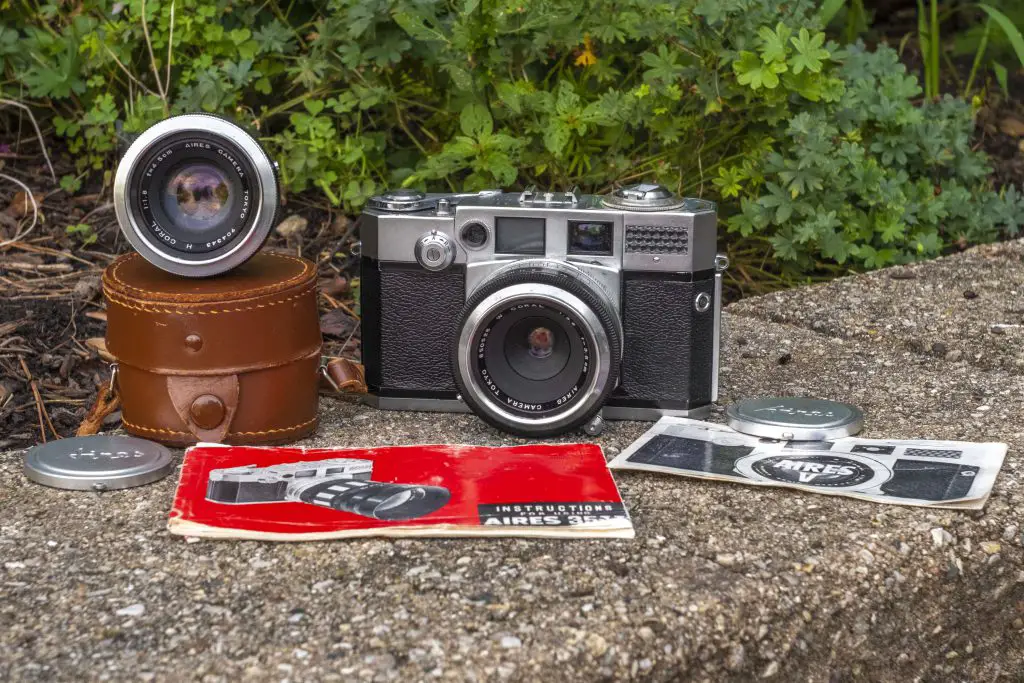
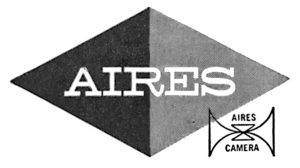
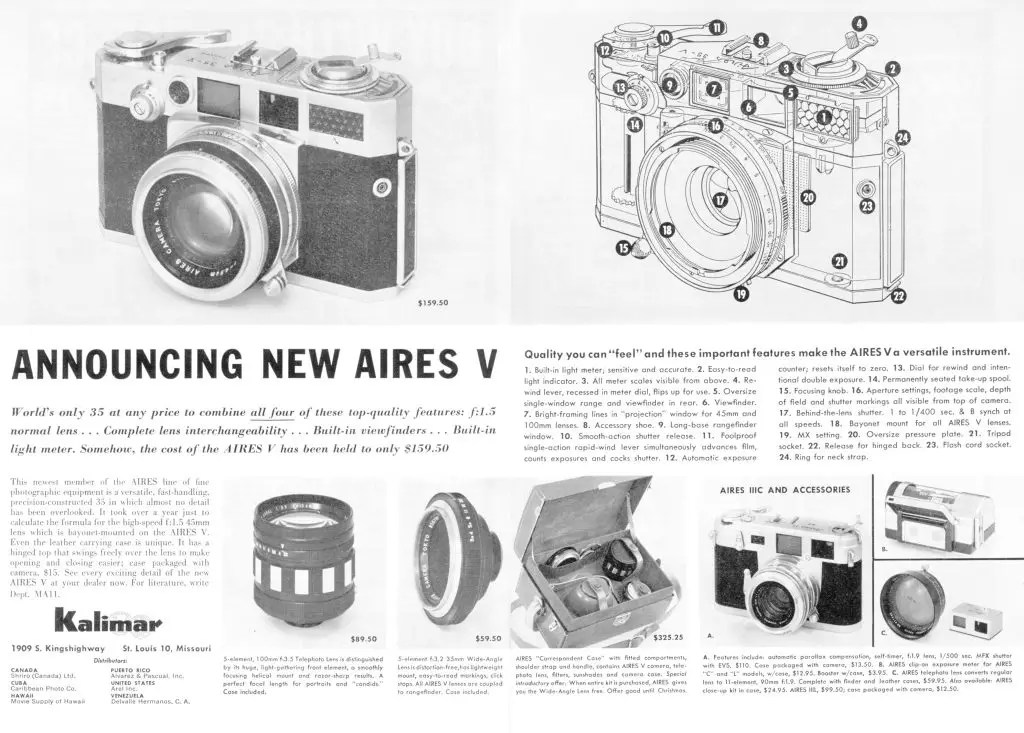



















I agree with your assessment of the Aires cameras and especially the 35V. I started with a IIIL and quickly had to move on to a IIIC because of it’s M3 lookalike styling. I had an opportunity to buy what was called a Correspondents Kit which included the 35v and 4.5/1.5 Coral along with the 3.5/3.2 and the 10.0/3.5 lenses, hoods and filters all in a fitted leather case. Still have after 12 yrs and love this complete kit. Never knew there was a 4.5/1.8 standard lens as it started out as a 4.5/1.9 which was the fastest lens Aires had used for their fixed lens cameras. When the IIIS was released in about the same time as the 35V, it had a 4.5/1.8 fixed lens, so eventually Aires must have made that available for the 35V.
As an aside, if the meter ever stops working in the 35V or IIIS, it is a simple procedure to remove and check the contact underneath for some corrosion. I have “fixed” two or three of these by cleaning the contacts and the meter springs back to life.
Great Japanese company but unfortunately like so many, failed in the 1960 economy blight and change of the worldwide camera buying habits of moving from these great rangefinder cameras to the SLR’s. One of my favorite collecting eras are the cameras of the late 50’s and early 60’s, not only for the epitome of most rangefinders but the infancy of the SLR market.
The color photos show that “vintage lens” look.
Someone gave me an Aires of some stripe. I don’t even know if it works. But it’s one heavy, heavy beast.
I heard about the Coral lenses when you were a guest on the Classic Lenses podcast. I went on to buy a Coral V with the 1.5 lens. I am delighted with the camera, even it the 60 + years show (for example, I have not figured out how to reset the frame counter to 0 after each roll). The camera is amazing, and so is the lens. I bought an L mount adapter and used it on a Panasonic S1 and the colors are amazing. There is flare when shooting directly into the sun, but that is it – colors are wonderful on film as well and focusing (even with the relatively small patch) perfect. Thank you for highlighting this camera/lens combination!
It’s good to hear that my appearance helped you find something new to buy! The Coral lenses are quite good, and Im impressed to hear that you got an adapter for the lens to digital. That is something I may consider doing to Fuji X-mount. I am sure someone had to have made one!
Can anyone suggest repair sources for older and lesser-known Japanese cameras? (I’m currently struggling with an Aires Penta 35, in fact.) One technician who repaired Petris in the fact no longer does so, and I likewise haven’t found anything for older Minoltas (such as early Hi-Matics).
Greaaat, another camera that I lusted after which will skyrocket in price…
Nah, it’s all good. These ones have always been rare, and the f/1.5 lens is like hen’s teeth. I’m not at all surprised by your struggle to focus the 4.5 cm lens – the base length on most Aires rangefinders is quite short, and that makes proper adjustment critical.
I also disagree on your saying that this camera debuted too late, when in fact it did so right at the peak of interchangeable-lens rangefinders. Between 1956 and 1960, a lot of ILC RFs “for the masses” were launched: the Agfa Ambi Silette, the Zeiss Werra, the Olympus Ace, the Canon P, the Argus C44, the Corfield Periflex “gold star”… The timing makes perfect sense when viewed through that lens, but unfortunately, the Aires had fierce competition, and the SLR would of course soon doom all of them to oblivion.
Thanks for the feedback! Perhaps I should have revised my statement about the timing of the 35V that while perhaps cameras like these still had a market, it was too late for Aires as I think their financial damage had already been done and the camera wasn’t enough to save the company. It’s a shame really as I’ve generally liked every single Aires camera I’ve had the pleasure to use, even some that I haven’t yet reviewed!
Thank you for your most informative post! I have begun collecting Aires cameras and lenses and am confused about the 3.5 10cm lens which I just purchased. My question is the focusing ring which has a very short throw when mounted on my Sony A7 with an Aires ra to Sony e adapter purchased on ebay. The throw is also short when the lens is not mounted on the camera. I’m wondering if something is wrong with the lens as I can only barely focus at the closest distance of around a meter. I would so appreciate if you have any advice. Thank you!
Audrey, thanks for the compliment on the article. I only have the standard and wide angle lenses for the Aires 35V, so I’m not entirely sure how the 10cm works, but according to the manual it looks like it has it’s own separate focusing helix. For the 3.5cm and 4.5cm lenses, the Aires 35-V has an in body focusing helix that is separate from the lenses which means that the throw of the focus arm (which is about 90 degrees by the way) is on the camera itself, not the lens.
I looked on eBay and found an Aires to Sony adapter from rareadapters.com that claims to have a fast helical which requires you to lock it before using the 10cm lens. Without both the 10cm lens and this adapter, I can’t be sure of exactly how it works, but my guess is the throw would probably be close to 90 degrees like the other two lenses. Does the lens focus correctly from 7 feet to infinity when mounted to your camera? If so, then it’s probably working fine. If not however, then there could be a fault with your lens. Good luck!
Aires Viscount was made in 1959-60. Most were sold in USA after Aires filed for bankruptcy in 1961. Offered at bankruptcy prices in the back of Popular and Modern photography Magazines. The cameras were exceptional in shutter and optics. Unfortunately they gave a contract to a American Distributor Kalimar, who wanted there Name on Aires products. Aires refused, Kalimar didn’t advertise their product per contract. Bankruptcy followed, caused by American Greed! That’s is the true sad story of, Aires Optical Camera Company.
This is good information Donald. Thank you for sharing!
Great review, I wrote 40 articles for Camerashopper magazine, so I like great reviews. Since I take cameras apart also, here are my tech thoughts. Rangefinder, superb design and easy to clean, no tricks. The large screw head on the top back right of the shutter is for adjusting the rangefinder collimation, use small moves. Cleaned this is a wonderful tinted rangefinder, w/o parallax correction.
Now the tough part the lens mount. Between the bayonet lens mount and the leaf shutter is three functions, focus helicoil, DOF guide ring, and shutter speed slector ring. All are fastened to one another by brass screws that are also glued. The straight slots are glued and very narrow . Hard to get out, often loose in non working 35-v bodies, its a struggle. Finally when you remove the square chrome cover plate the large round 0 sized shutter is exposed. It’s an exact copy of a Compur shutter of 1958 that is. Removing the cover requires turning the round screw with 3 tiny pin holes in it to the flat section. Then turn the round cover till the curves line up and lift off. All the guts of the shutter are there. Unfortunately the shutter blades are under the gears. So….
Open the back and remove the four screws in the film guide. Now the really hard part. The lens is mounted on a brass threaded tube, which is glued and a challenge to remove. Once done access to the shutter blades is finally possible. This is a very strong design of shutter blade with strong spring tension. So that is it, the brass screws are a design flaw. They loosen with use and break. Their threads are tiny and soft. Gluing them in, made it hard to repair. Regards, Don
Donald, thanks for your insights into working on the Aires 35V. I like this camera enough that I may consider getting it repaired. It’s such an attractive camera and Aires Coral lenses have always produced excellent results, it’s a shame to let this sit on my shelf in it’s current state.
Hi Mike, there is an Expert and Enthusiast for Aires Cameras in Germany who makes professional repairs. The Problems of your 35 V seem to be typical and pretty easy to fix if one knows what to do but are demanding caution as he writes, because using it anyway on could cause full damage to the mechanism. You‘ll find the contact on the website „lichtgriff.de“ (Information is only in German but surely he will answer in english if one writes him so).
Thanks for your great articels!!
Hi Mike. Great write up! Sad to hear your camera is gritty and stiff, my 35-V is buttery smooth winding. The shutter was frozen when I got it, but a simple swabbing with Naptha followed by 91% alcohol and some exercise restored the shutter nicely. My meter isn’t responding, but I’ll give it another stab with Gary A. Hill’s comment above; hope it works. I just ordered into 2 more lenses and a spare body, so I should be set with 2 bodies and the 3 standard lenses. I really like the ergonomics and build of this camera. I agree it’s a poor man’s Leica! Thanks!
My Aires 35V is one of the few cameras I would consider one day sending out for a CLA as I really do like it. Maybe someday when I’m done buying new cameras to review, I can finally start spending money on repairing the ones I have! 🙂